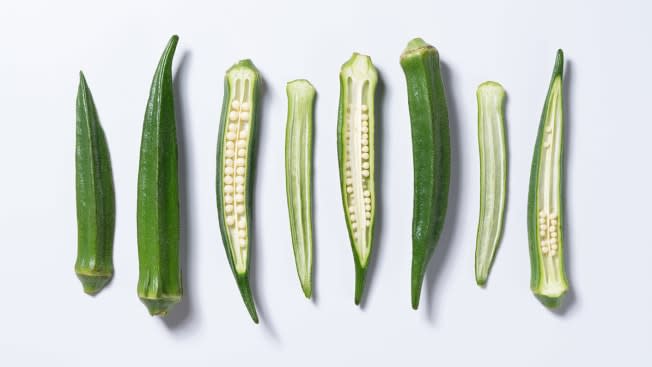Is Okra Good for You?

By Marisa Moore
Every vegetable has its devotees and detractors, but okra may be one of the most polarizing. That’s often due to its reputation for being slimy. When you cut into it, okra releases a gooey substance called mucilage, which is great for thickening stews, but can also give cooked okra a slippery texture.
Lack of familiarity is another reason. Although okra is a staple in southern cuisine, it’s not as ubiquitous in U.S. supermarkets as say broccoli, and people wonder what to do with the fuzzy green pods.
If a fear of slimy okra has ever kept you from giving it a try, there are ways around it. And they’re worth exploring, because okra is really good for you.
A Brief History of Okra
Okra is believed to have its origins in present-day Ethiopia or South Asia. Many sources agree that the vegetable made its way to the United States through the transatlantic slave route from West Africa to the Americas sometime between the 16th and 19th centuries.
It thrives in warm climates, and is grown in abundance from late spring to early fall in the Southern states (and it’s available frozen year-round). But it’s also commonly eaten in other parts of the globe, including West Africa, North Africa, India, and South Asia, and the Middle East. Okra has many names around the world including, lady fingers, gombo or gumbo, bhindi, and more.
You typically see green pods in grocery stores and farmers markets, but okra also comes in a rich burgundy color that turns green once cooked
Okra Health Benefits
The thing some people dislike about okra—the slime—is part of what makes it good for you. The gel-like substance is rich in soluble fiber, known for its potential to lower blood cholesterol and be fermented in the gut, supporting the growth of healthy bacteria. These bacteria help break down food, synthesize vitamins, prevent bacteria that cause illnesses from getting a foothold, and bolster immunity. Fiber in general helps you stay full after a meal, and a cup of cooked okra has 5 grams of total fiber—nearly a fifth of the daily fiber recommendation.
That same size serving supplies 67 percent of the daily need for vitamin K, important for heart health and cognitive function. You’ll also get about a third of your daily need for vitamin C, which is important for immune support, and nearly a quarter of your daily magnesium, a key mineral for energy production and a host of other essential functions in the body. One cup of cooked okra provides an impressive 88 mcg of folate—22 percent of what you need—a B vitamin that’s essential for anyone who is or might become pregnant as it helps prevent neural tube defects.
But wait—there’s more! “The phytonutrients and polyphenols in okra may help to quell systemic inflammation [and] reduce oxidative stress by blunting free radical damage,” says Maya Feller, MS.RD.CDN, author of The Southern Comfort Food Diabetes Cookbook.
Okra might also help with blood sugar management and reduce the risk of certain cancers, but researchers say more data is needed in people to confirm these potential effects.
How to Cook Okra
Botanically speaking, okra is a fruit, but it’s commonly cooked and eaten as a vegetable. With its unique texture and sweet, grassy fresh flavor, okra is versatile in the kitchen.
"As a South Asian/Central Asian dietitian, okra, or bhindi, is a regular in our diet,” says Shahzadi Devje, RD, owner of Desi~licious RD Inc in Toronto. “From bhindi masala to Kurkuri bhindi (crispy), aloo (potato) bhindi, and bamia (stew)—we relish them all.”
You can add okra to soups and stews where its gel will blend in and thicken the dish. Think Cajun gumbo or “callaloo, a popular dish in Trinidad and Tobago, made with okra, leafy greens, and pumpkin. “This thick flavor-filled topping can be served alongside rice or enjoyed alone.” notes Feller. Gullah Geechee, or Lowcountry okra soup, is a West African dish that combines okra with meat, rice, and vegetables in a flavorful broth. Okra also adds body to succotash, a traditional Native American dish made with lima beans, corn, and okra popular in the south and in New England.
For a slime-free okra dish, there are a few things to keep in mind. “When cooking okra, it is essential to keep everything dry, from the cutting board and knife to the okra itself,” says Manju Karkare, RDN, owner of Nutritionally Yours, a nutrition consulting company in Raleigh, N.C. That means skipping the lid when you sauté okra to ward off excess steam and liquid. And avoid overcooking it. Choose recipes that cook okra quickly with high heat such as roasting or sautéing.
You could start with fried okra, a crispy, crunchy beloved Southern dish that’s commonly served as an appetizer or a special summer side dish. For this, sliced okra is traditionally dredged in a seasoned cornmeal-flour mix and quickly deep-fried until golden. When making it at home, you can use as little breading as you’d like. And if you need another reason to celebrate, fried okra retains its impressive fiber factor.
If you want to avoid deep frying, you can roast, oven- or air-fry okra for a similar effect. Simply spritz the dredged okra with a neutral oil (such as canola) and air-fry or oven roast in a single layer at about 425º F until crispy.
Pairing okra with an acid—tomatoes, vinegar, tamarind, or lemon juice, also keeps it from getting slimy, Karkare says. Tomatoes and okra are an especially delicious combo. Try roasting the pods with grape or cherry tomatoes tossed in a little olive oil. Or briefly marinate okra in lemon juice and olive oil and roast topped with some parmesan cheese. Or try one of Karkare’s family favorites: sautéed okra seasoned with mustard seeds, turmeric, curry leaves, and green chilies.

